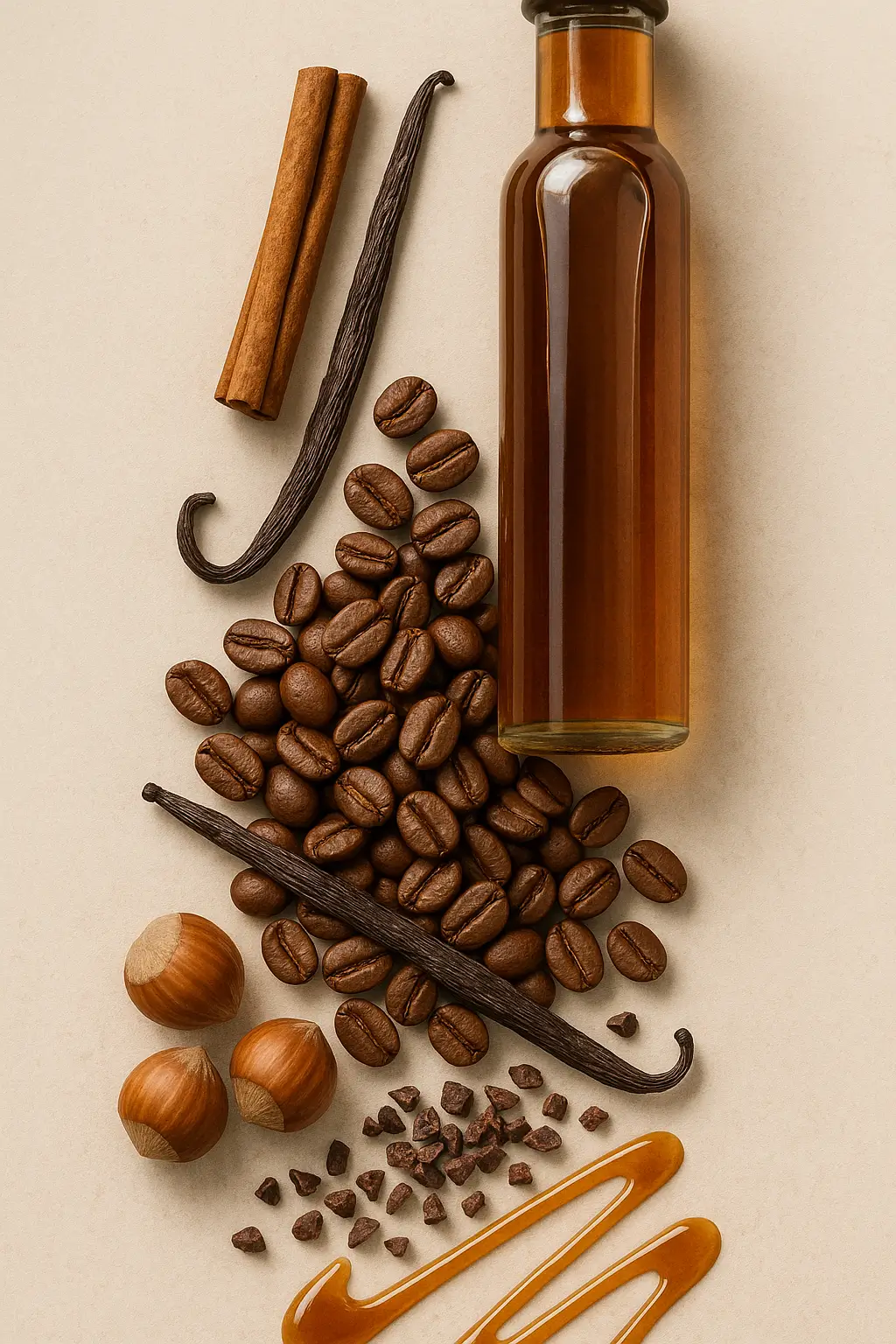The smell of fresh coffee fills kitchens and cafes daily. But for many, coffee offers more than just the traditional roast. Think about flavored coffee. It’s popular worldwide, grabbing attention and taste buds. Unlike pure coffee, flavored versions use a coffee bean infused with extra flavors. This changes its natural taste. People are curious about how it’s made and if it’s healthy. So, it’s good to understand this special coffee.
What is flavored coffee?
Flavored coffee takes roasted coffee and adds external tastes and smells. Workers typically apply natural flavoring agents or artificial flavoring agents to roasted beans. They use oils or extracts. The main thing about flavored coffee is these added flavors. They change or boost the original taste of the coffee bean. Flavors can be subtle—like a hint of vanilla—or stronger. Think rich caramel or even bold whiskey. These added elements give you a different coffee experience. You get tastes beyond what the bean naturally offers.
How do producers make flavored coffee?
Producers use several ways to get flavor into coffee beans or the final product. These methods ensure the coffee absorbs the right smell and taste. They apply flavors at different steps. From roasting to brewing, each method creates a unique flavored blend. Knowing these processes helps you see the work behind your favorite special coffee.
Flavoring during roasting
During roasting, producers add flavoring agents right to the coffee bean. This happens before or during heating. They use flavored oils, sprays, or even whole spices. Think cinnamon sticks and vanilla beans. As beans expand during roasting, they absorb these flavors deep inside. Adding cocoa nibs, for example, gives the bean a natural chocolate taste.
Flavoring after roasting
After roasting, producers often coat roasted coffee beans with flavor oils or extracts. Manufacturers tumble the beans gently in a mixer. They spray them with concentrated liquid flavors. Then, the beans dry. This helps the flavor stick to the surface and soak in. You get a stronger, more noticeable taste. This method lets producers control the final flavor and its strength precisely.
Using natural flavorings
Natural flavoring agents use real ingredients for subtle, authentic tastes. Producers mix natural items like dried fruits, nuts, spices, or herbs with coffee beans. They can add these during or after roasting. This gives a more genuine and nuanced flavor than artificial methods. Imagine adding whole cardamom pods—they give a delicate, spicy note.
Post-brewing flavoring
Post-brewing flavoring means you add flavored syrups to your coffee after it’s brewed. You get a “flavored coffee” without the beans themselves being flavored. This lets you customize your drink. You can add vanilla, caramel, hazelnut, or chocolate syrups to hot or iced coffee. This is different from beans flavored during manufacturing.
Flavoring instant coffee
For instant coffee, producers add flavor during the first step: coffee extraction. They infuse the coffee extract with specific flavors. This happens before drying methods like freeze-drying. The taste and smell get locked into the coffee powder. When you add water, the flavor is still there. This makes flavored instant coffee easy and consistent to make.
Common flavoring agents in coffee
Coffee uses many different flavoring agents. These can be natural or artificial. They give coffee distinct tastes. These agents create the wide range of flavored coffee you see today. Manufacturers pick and apply them carefully. They want specific smells and tastes—anything from fruity and nutty to spicy and sweet.
Natural extracts and essential oils
Natural extracts and essential oils come from spices, fruits, nuts, and herbs. They are common natural flavoring agents. Think vanilla extract, almond extract, and hazelnut extract. These give rich, real tastes. Other popular natural flavors include caramel, chocolate, cinnamon, and pumpkin spice—that autumn mix of pumpkin, cinnamon, and nutmeg. You can also find exotic additions like cardamom and different citrus oils. They add bright, fragrant profiles to flavored coffee.
Whole spices and ingredients
You can add whole spices and ingredients directly during coffee preparation or roasting. This infuses subtle, real flavors. For example, producers might add cinnamon sticks, actual vanilla beans, or roasted cocoa nibs to the beans. This gives a more nuanced, less artificial taste than liquid extracts. These ingredients create a deeper, more natural flavor that grows with the coffee.
Artificial flavorings
Artificial flavorings are chemicals made to copy natural tastes. They help balance taste and cost in the flavored coffee industry. The term “natural flavor” can be confusing. But artificial flavoring agents are clearly man-made. They deliver steady, strong flavors. They also offer more flavor choices and often keep the flavor stable for longer.
Popular flavored coffee varieties
Many people love flavored coffee. Favorites include hazelnut, vanilla, and pumpkin spice. These offer different tastes that appeal to many. They often link to seasons or moods. This variety serves both traditional and adventurous palates. Flavored coffee becomes a flexible choice for many people.
- Hazelnut flavored coffee: This classic offers a nutty, slightly sweet smell, a timeless favorite,
- Vanilla flavored coffee: Enjoy a creamy, sweet, comforting taste, often chosen for its flexibility,
- Pumpkin spice flavored coffee: A seasonal favorite, popular in autumn, it blends warm cinnamon, nutmeg, and clove,
- Caramel flavored coffee: Get a rich, buttery, sweet taste, almost like dessert in a cup,
- Chocolate flavored coffee and mocha flavored coffee: These combine rich cocoa with coffee for a decadent experience,
- Mint flavored coffee: Feel refreshed and cool, perfect for a gentle lift,
- Blueberry flavored coffee: It brings fruity sweetness and a slight tartness, giving a bright, fresh taste,
- Coconut flavored coffee: Smooth, creamy, and subtly nutty, many enjoy this as iced coffee,
- Other unique choices include butterscotch flavored coffee, pecan flavored coffee, French vanilla, Amaretto, salted caramel, chocolate raspberry, vanilla lavender, and toasted coconut mocha.
Flavored coffee versus naturally aromatic beans
Flavored coffee is different from naturally aromatic coffee beans. Flavored versions are roasted coffee beans that get external flavors added. Naturally aromatic coffee beans, though, get their smell and taste only from their natural traits and the roasting process. The key difference is where the flavor comes from—it’s either natural or added.
Key differences: Flavored versus naturally aromatic coffee
The main difference between flavored coffee and naturally aromatic coffee beans is where their flavor comes from. For flavored coffee, producers add flavor oils or extracts to roasted coffee beans after roasting. This gives them outside tastes like vanilla or hazelnut. But naturally aromatic coffee beans get their flavor and smell from the bean itself. Think floral, fruity, or earthy notes. These develop as the bean grows and during natural processing. Their flavor comes from the specific bean variety, growing conditions, and roasting—no added stuff.
| Aspect | Flavored Coffee | Naturally Aromatic Coffee Beans |
|---|---|---|
| Bean Base | Regular roasted beans | Specialty or regular beans |
| Flavor Source | Added natural or artificial flavor oils/extracts | Inherent bean characteristics and roasting |
| Flavor Development Timing | After roasting (infused or coated) | During growth and roasting |
| Examples | Vanilla, hazelnut, caramel, pumpkin spice | Floral, fruity, chocolatey notes naturally present |
Why this distinction matters
Knowing the difference between flavored coffee and naturally aromatic coffee beans helps you choose better. It also affects how you see flavor purity. If you want the pure taste of a coffee bean, naturally aromatic types offer flavor from their origin and processing alone. Flavored coffee, however, gives you an enhanced experience. It appeals to those who want bolder tastes beyond the bean’s natural notes. The flavor source changes how you view quality and authenticity.
Health and nutrition: Flavored coffee
Drinking flavored coffee brings up health questions. It impacts your nutrition, mainly because of additives and synthetic ingredients. These often include things like propylene glycol, diacetyl, artificial sweeteners (like sucralose and aspartame), synthetic oils, hydrogenated fats, and preservatives like potassium sorbate. Such additives might pose health risks. This contrasts with the benefits of pure black coffee.
Potential health risks from additives
Additives in flavored coffee can risk your health. They might affect different body systems. For example, propylene glycol and potassium sorbate link to nervous system symptoms. These include headaches and dizziness. They might also cause genotoxicity—damage to cell DNA. Diacetyl, an artificial butter flavor, has ties to severe respiratory problems, especially for workers exposed often. Some additives can also cause digestive issues, disrupt hormones, and cause body-wide inflammation. If you regularly drink products with these synthetic compounds, be careful. Think about their long-term effects.
Here are common additives and their possible risks:
- Propylene glycol: Can cause nervous system issues like headaches and dizziness, and might damage genetic information,
- Diacetyl: Primarily links to breathing problems, especially with long exposure,
- Artificial sweeteners (like sucralose, aspartame): May add to metabolic stress and insulin resistance,
- Synthetic oils and hydrogenated fats: Could worsen inflammation and contribute to heart concerns,
- Potassium sorbate: A preservative, also tied to nervous system symptoms and potential genetic damage.
Nutritional impact
The nutritional impact of flavored coffee depends on its ingredients. Especially if it has added sugars, trans fats, or other chemical additives. These can spike your blood sugar. They might also upset your gut microbiota and cause body-wide inflammation. Pure coffee has no calories. But artificial flavorings, sweeteners, and fats add unwanted calories and unhealthy compounds. This often cancels out the good nutrition of a plain cup of coffee.
Flavored versus pure black coffee: A health contrast
Flavored coffee is very different from pure black coffee for your health. Pure black coffee has many antioxidants and helpful compounds. These might lower your risk of some chronic diseases—like certain cancers, diabetes, and heart disease. But additives and synthetic ingredients in flavored types can cancel out these benefits. Pure coffee helps your health. Flavored versions, especially if you drink them often with added sugars and fats, bring risks. They can reduce your overall wellness.
Why “natural flavor” labels mislead
The term “natural flavor” on flavored coffee labels can confuse you. These flavors come from natural sources. Yet, they often go through complex processing. They can contain many hidden chemicals. So, a “natural flavor” might still hide synthetic substances or highly processed ingredients. These might not be fully tested for long-term safety. You might think these products are pure or unprocessed. In truth, they use complex chemical formulas to create specific tastes.
How to choose flavored coffee wisely
Choose flavored coffee wisely. Look for products with clear ingredient lists. Drink them in moderation. Picking organic flavored coffee is smart. It helps cut down exposure to harmful additives like propylene glycol and potassium sorbate. Read labels carefully. Find hidden sugars, artificial sweeteners, or too many chemical additives. Enjoy flavored coffee as an occasional treat, not a daily habit. This also lowers risks from long-term exposure to these ingredients.
Flavored coffee gives you a diverse and appealing choice beyond traditional brews. It adds many taste profiles to your coffee experience. It stands apart from naturally aromatic beans by adding external natural flavors or artificial flavors. This changes a simple coffee bean into a unique drink. Production methods vary—from flavoring during roasting to adding syrup after brewing. But the core idea is always to enhance the taste. You should also think about the health considerations from additives and synthetic ingredients in these products. Make smart choices. Maybe pick organic types or drink them in moderation.









